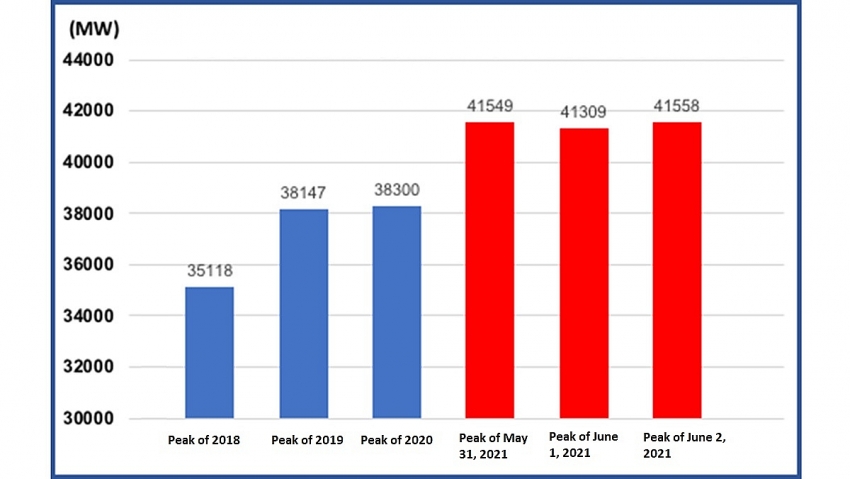A paradox of power consumption and generation
 |
| Power consumption is breaking record levels this year |
Numerous areas across Vietnam have been experiencing blackouts due to elevated power consumption breaking historical records during the June heatwaves. The Electricity of Vietnam's (EVN) National Load Dispatch Centre (NLDC) said the electricity demand across Vietnam has broken a new record on June 21, with 42,146MW.
The increased demand has been resulting in more frequent overloads of the national grid, the weakest link in the power chain, which can accommodate neither the demand nor the current supply of power, traditional or renewable. This has resulted in outages even in the districts across the capital Hanoi, and other cities and provinces across North and North-Central Vietnam in June.
Just last week, power went out unexpectedly at the VOV building in Hanoi’s South Tu Liem district for a whole morning, leaving offices in the building stranded.
Nguyen Son, an office staff at the building said, “We saw some electricians fixing something in the building. We called the EVN hotline and were told the outage was unscheduled and happened due to power shortages so there was no way they could have warned in advance.”
During the end of May and the whole of June, electricity consumption in the north and north-central region soared sharply to 15 per cent above the corresponding figure in 2020, especially between 8 and 10pm. To prevent overloads to the grid, EVN was forced to reduce energy supply by 500-2,000MW and issued recommendations for people, businesses, and authorities to reduce electricity consumption during rush hours, especially at noon and in the evening.
Ngo Son Hai, deputy general director of EVN said that the grid faces extreme loads during the summer. However, increasing renewable generation (especially solar rooftop) has made a tangible difference on the load on the national power grid.
As of date, Vietnam's total renewable energy capacity is 22,250MW, twice as much as in 2020, making up 31.2 per cent of the total installed capacity. “The increased generation capacity has made it harder to maintain the national power grid,” said Hai.
While high power consumption lead to overloads and the NLDC has been forced to temporarily cut electricity in some areas, numerous renewable energy plants are forced to generate below capacity. In the first four months of 2021, the NLDC ordered reducing renewable energy generation by 470 million kWh (including 447.5 million kWh for solar farms, equivalent to 13.3 per cent of total generation capacity, and 19.7 million kWh of wind power, or 4.8 per cent).
Throughout the year, 1.68 billion kWh of renewable energy generation will be foregone, including 1.25 billion kWh of solar (9 per cent of total generation capacity), and 430 million kWh of wind power (7 per cent).
Dong Trung Kien, an expert with almost 20 years of experience in the field said, electricity consumption has two peak time periods during the day and night, the latter of which solar power during the evening peak hours (from 6.30 to 10pm).
“To bridge demand and generation capacity, we need storage facilities which is a common issue over the world requiring heavy investment. Solar energy, especially solar rooftop, is developing at a tremendous pace, but without the means of storage, their output needs to be consumed instantaneously,” said Kien.
He also provided some solutions to store solar power such as hydroelectric storage (currently the most efficient storage technology) or biomass conversion.
What the stars mean:
★ Poor ★ ★ Promising ★★★ Good ★★★★ Very good ★★★★★ Exceptional
 Tag:
Tag:
Related Contents
Latest News
More News
- Schaeffler reports strong early output from Dong Nai solar project (December 12, 2025 | 15:16)
- Forestry conference highlights biodiversity and sustainability goals (December 09, 2025 | 13:35)
- Home Credit honoured among top 10 sustainable companies in trade and services (December 09, 2025 | 12:18)
- SCG and seven member companies honoured in Top 100 Sustainable Businesses 2025 (December 08, 2025 | 09:00)
- Nestlé Vietnam pioneers sustainable development and promotes business connections (December 06, 2025 | 12:09)
- CSI 2025 highlights rise of Vietnam’s green champions (December 06, 2025 | 09:00)
- Acecook Vietnam named among top 100 sustainable businesses (December 06, 2025 | 08:00)
- Vietnam’s forest carbon credits draw global interest (December 05, 2025 | 17:41)
- Coro Energy to launch BESS Pilot in Vietnam (December 04, 2025 | 15:12)
- Vietnam strengthens energy storage pathway (December 04, 2025 | 15:05)




























 Mobile Version
Mobile Version